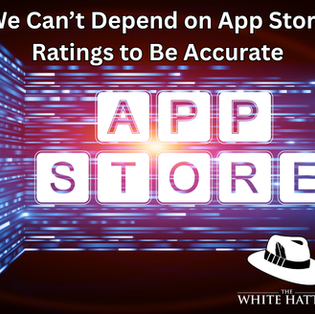We Can’t Depend on App Store Ratings to Be Accurate
- The White Hatter

- 1 day ago
- 3 min read

When parents browse the Apple App Store or Google Play, it’s easy to assume the age ratings listed for each app are trustworthy. Unfortunately, that confidence may be misplaced.
In 2022, the Canadian Centre for Child Protection published a report titled “Reviewing the Enforcement of App Age Ratings in Apple’s App Store and Google Play.” (1) The findings were eye-opening, age ratings often failed to reflect the actual risks or content youth could encounter once the app was downloaded. In some cases, apps marketed as safe for children contained mature themes, unmoderated chat features, or exposure to strangers, issues parents would never expect from the rating alone.
Parents rely on age ratings to make informed choices. When those ratings are inconsistent or misleading, kids can be exposed to inappropriate or even dangerous content. It should also be noted that the age ratings they use, although similar to the Entertainment Software Rating Board (ESRB) ratings, they are not endorsed by the ESRB. The report raised serious concerns about how tech companies define “safe for youth” and whether the enforcement of age policies is rigorous enough to protect young users.
Wouldn’t it be great if parents could turn to a trustworthy, third-party source that evaluates apps honestly and independently? Fortunately, such tools exist.
Common Sense Media has long been a reliable resource, providing independent reviews and age-appropriate ratings for apps, games, movies, and shows. It offers detailed insight into language, violence, sexual content, and data privacy so parents can make informed choices before allowing a download. (2)
The App Danger Project, hosted by the University of Massachusetts (UMASS), is another valuable resource. (3) Researchers behind this initiative examined how app store reviews often bury critical warnings from users reporting issues like grooming, sexual exploitation, or predatory behaviour. Their analysis revealed that even within app store reviews, serious red flags about child safety can be difficult for parents to find. By collecting and organizing these hidden warnings, the App Danger Project gives parents a clearer view of the potential dangers that might not appear in official app ratings or promotional material.
Although the project’s scope is currently limited, it represents an important step toward greater transparency in how apps are assessed. The team hopes to expand their database in the future to include more platforms and categories of risk.
Before granting permission for a new app, download and explore it yourself. This firsthand look often reveals features or interactions not mentioned in the app description. It’s also an excellent opportunity to model critical thinking for your child.
Psychologist Jocelyn Brewer recommends having children complete a short “Due Diligence Report” before installing any new app, a practice we’ve highlighted before at The White Hatter. (4) The idea is simple, your child researches the app, reviews safety information, checks privacy settings, and presents their findings to you. It helps them build digital literacy and understand their own responsibilities online.
For parents of iPhone users, there are also helpful third-party tools that can add extra layers of protection:
“The Brick”, a small hardware device that prevents unauthorized app downloads. (5)
“BrightCanary”, a parental monitoring app that helps manage and review app activity. (6)
Keep in mind that the iPhone wasn’t originally built for children or young teens, it was designed with older teens and adults in mind. For kids under 16 who don’t yet have a phone, we recommend starting with a minimalist option like the Pinwheel phone. (7) It looks and operates much like a smartphone but restricts access to the internet and app stores, offering a safer first step into digital independence. Another option is the Sunbeam phone (8)
Tech companies are not always transparent when it comes to the risks hidden in their products. App store age ratings can be a starting point, but they should never be the final word. By using independent resources like Common Sense Media and The App Danger Project, and by taking time to test apps firsthand, parents can make better, more informed decisions to protect their kids in today’s onlife world.
Digital Food For Thought
The White Hatter
Facts Not Fear, Facts Not Emotions, Enlighten Not Frighten, Know Tech Not No Tech
References:
4/ https://www.thewhitehatter.ca/post/ensuring-app-safety-for-teens-a-guide-for-parents-and-caregivers














